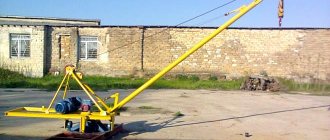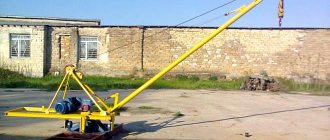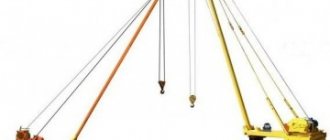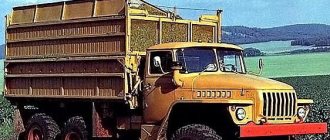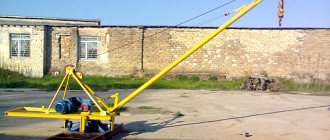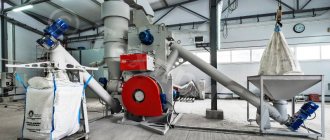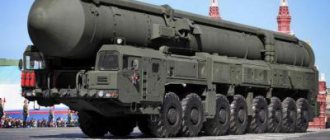Special strategic missile carrier
At the end of the 1970s, UGK-2, under the leadership of Vladimir Efimovich Chvyalev (the future chief designer of MZKT), designed a new special heavy chassis MAZ-7916 for transporting missile launchers. Its carrying capacity was 63 tons. It was designed for specific weapons - as a launcher for the 15P642 Temp-2C missile system with a 15Zh42 ICBM.
"Temp-2S" was a Soviet strategic mobile ground-launched missile system (GGRK), with a solid-fuel intercontinental ballistic missile. It was intended to strike well-protected air defense and missile defense systems; the most important objects of its military and industrial infrastructure located deep in the enemy’s territory.
Years of development: 1965–1976; was in service with the Soviet Strategic Missile Forces from 1976 to 1985. In total, seven regiments of strategic missile forces were armed with this complex.
Based on the Temp-2S missile system, the Pioneer missile system with a medium-range ballistic missile was created. It was in service until 1991.
Place of the MAZ-7916 model in the plant’s production line
The new rocket carrier was created on the basis of the already produced MAZ-7905 and MAZ-547A vehicles, but received new units and a different, “moderate” front overhang of the frame, which was only 3960 mm. A new model was created taking into account the shortcomings of previous machines of this type identified during operation.
In particular, during the operation of MAZ-547V trucks with Pioneer missile systems, a number of serious shortcomings appeared. Namely, the poor placement of special technological equipment, two cramped and uncomfortable single-seat cabins for the driver and crew commander, one of which was elevated and did not provide a wide view, and was also characterized by serious vibration. At the same time, there was no permanent place for the third crew member - the launcher operator.
In 1980, UGK-2 of the Minsk Automobile Plant developed a six-axle MAZ-7905 vehicle with a carrying capacity of 58 tons, created on the 547A chassis and for some time occupied an intermediate position between the 547 series trucks and the newest family of seven-axle rocket chassis.
Considering that its main task was to replace the MAZ-547B truck, on the new chassis the front overhang was extended to almost 5 meters, and special technological equipment and 2 identical single-seat cabs from the 547A model were transferred to it. This solution completely eliminated vibrations in the cabins, improving the working conditions of the crew, achieving an incredibly smooth ride. Witnesses of those events recalled with surprise and pleasure that this smooth ride turned out to be so expressive that while driving, drivers sometimes felt motion sick and sleepy, and small objects left on flat surfaces remained in place throughout the entire test cycle.
However, the angle of the climb has been significantly reduced, and the cross-country ability has been seriously affected. But on normal dirt roads these qualities were not decisive.
The most important technological innovation of the MAZ-7905 truck was the use of a tank-type V-58-7 V12 engine with a capacity of 710 horsepower. The total chassis weight of this model was 30 tons.
Until 1982, six experimental MAZ-7905 vehicles were assembled, which entered state tests at the 21st Scientific Research Institute, and at the same time, installation of the Pioneer UTTH missile systems began on a trial basis on 5 of them. However, the test results were not impressive: they demonstrated a deterioration in the chassis' cross-country ability and maneuverability, insufficient payload and poor handling.
The consequence of this was the closure of this project. Preference was given to MAZ-7916.
For the first time, new lightweight fiberglass cabs were installed on the MAZ-7916 multi-axle special truck: the left one is two-door and two-seat, and the right one is single-seat. This solution allowed the entire crew of the missile launcher to each have their own workplace in one vehicle.
This new and advanced version of the missile-carrying truck served as a good experimental basis for testing promising design ideas and cabins, for studying the possibilities of using new diesel power units - with the subsequent implementation of the results developed during operation on the MAZ-7917 seven-axle missile chassis.
However, in the end, in accordance with the Intermediate-Range Nuclear Forces Treaty, signed by Gorbachev and Reagan in December 1987, all these missile systems were destroyed. Their literally barbaric Elimination was somehow barbaric: the rear part of the frame was cut to a length of 78 cm (exactly the place in the car where the lifting and supporting mechanisms of the rocket were mounted). Subsequently, this method was replaced by a simpler, cheaper and less labor-intensive method of exploding missiles directly inside the launch containers.
The project thus came to an end, but as a result of work on the further step-by-step development of the Temp-2S and Pioneer systems in the 1980s, the 15P158 Topol mobile missile system was created.
But let's go back to the beginning of the production of MAZ-7916 trucks.
Links[edit]
- "湖北三江航天万山特种车辆有限公司". wstech.com
(in Chinese). Archived from the original on 2015-10-30. - "中国航天三江集团". cssg.com
(in Chinese). Archived from the original on 2009-02-21. CS1 maint: discouraged parameter (link) - "CAZICA". english.casic.cn
. Archived June 21, 2013. CS1 maint: parameter deprecated (link) CS1 maint: bot: original URL status unknown (link)
About the history of the creation and production of MAZ-7916
The first prototype of the MAZ-7916 heavy truck was built in November 1979, and then it was followed by four more prototype chassis. All these cars were equipped with a B-58-7 diesel power unit with a capacity of 710 horsepower, a modernized torque converter, a four-speed hydromechanical transmission (used in the 547 series), drive axles with a permissible load of 14.7 tons each and a pressure control system tires
In comparison with its predecessors - the MAZ-547 trucks - the curb weight of the MAZ-7916 model increased by four and a half tons, reaching 32 tons. Its overall length increased by 820 mm and reached a value of 16,320 mm. The minimum turning radius increased from 22 to 27 meters, the highest speed on the highway was 45 km/h. The MAZ-7916 chassis successfully passed operational tests.
There is information that, as a result of their results, in subsequent years the following batch was produced in Minsk - twenty-six vehicles, specially designed for the installation of equipment for the modernized Pioneer-3 launcher of the new generation.
The medium-range mobile missile system "Pioneer-3" (up to 7.5 thousand kilometers) was developed since 1983 and was placed on a specially prepared MAZ-7916 chassis, the re-equipment of which was carried out by the defense in the city of Volgograd.
The complex had two experimental basic versions, with different types of new seventeen-meter missiles: version 15P655 with a monoblock 15Zh55 missile with a thermonuclear warhead and 15P657 with a 15Zh57 missile equipped with three independently targetable multiple warheads.
This missile system underwent specific field tests in May 1985, followed by its final state tests in 1988. Unlike the systems that preceded it in the first years of production, Pioneer-3 was equipped with new control equipment and gained increased accuracy in shooting.
The complex was equipped with new systems for aiming, control of the launcher with an on-board digital computer and a hydrostabilized platform based on float gyro devices, which ensured a strictly horizontal position of the missile during combat duty and the specified firing accuracy without turning the entire installation.
The total mass of the SPU was 83 tons, the maximum permissible speed was 40 km/h.
The launcher on the MAZ-7916 chassis had in its rear part devices designed to bring the transport and launch container from the traveling position to the firing position and back. Additionally, the vehicle was equipped with special hydraulic jacks, which were used to unload the chassis, level and ensure the stability of the launcher when launching a rocket.
In general, the MAZ-7916 retained the chassis layout solutions of the 547th MAZ model. In appearance, this new vehicle differed from its predecessors only in its slightly larger dimensions and crew cabins of a new design. The estimated mileage was at least 18 thousand kilometers, in terms of the power unit - 500 engine hours, and the warranty period of operation and storage was ten years.
In the long-term production plan for 1986-1990, it was planned to design an even more advanced and advanced missile system “Pioneer-4”, but these developments were interrupted and finally crossed out by the signing in December 1987 of the Treaty on the Elimination of Intermediate-Range Missiles between the USSR and the USA . As a result, all work on new missile systems and chassis was stopped, and before May 1991, several prototypes of the Pioneer-3 SPU were destroyed along with the rest of the Pioneer systems of the first releases.
And the MAZ-7916 cars were sent “for conservation” from them. Simply put, they were left to rust in the open air in military units that were awaiting disbandment during military reforms. Those MAZ-7916 that were preserved in such “preservation” were gradually overgrown with bushes and trees and began to be uncontrollably taken away for scrap metal.
Several MAZ-7916 chassis were sold to Pakistan, where, in a converted form, with special body superstructures and cabins, they became carriers of the local Shahin and Hatf Babur strategic missile systems. And in the DPRK, on an independently modified version of a heavy chassis that combined elements of the MAZ-7916 and MAZ-547V vehicles, they began to install equipment for launchers with Musudan ballistic missiles.
Only a small number of these multi-axle vehicles were more fortunate than others: their chassis, after dismantling special military equipment, was used for civilian purposes: for the installation of heavy-duty crane equipment (KS-7571). The conversion of rocket carriers into heavy-duty cranes (25 tons) was carried out at the Odessa plant named after the January Uprising, in collaboration with Liebherr.
In addition, in 1994, on the basis of this chassis, the MZKT-79161 multi-axle truck was created - a fifty-ton version of the vehicle intended for the installation of military and civilian special equipment. As a result, two models of gigantic truck cranes were produced: KS-5571 - for military purposes; and on its basis - KS-5573, already for civilian use. But these were, of course, literally one-off specimens, rare.
The Kirov Machine-Building Plant (KMZ) also collected single samples of the heavy diesel-electric truck crane KS-8467 with a lifting capacity of up to one hundred tons and a boom length of forty meters. This super crane was used by coastal units of the Russian Navy to load weapons and heavy cargo onto submarines.
Technical characteristics of MZKT-MAZ-547
- Home page
- MZKT
- MAZ-547
| MAZ-547A 12×12 '01.1970–85 | MAZ-547V 12×12 '1974–84 | |
| 1970–1985 | 1974–1984 | |
| basic | ||
| steering wheel location | left | |
| Number of doors | 2 | |
| number of seats | ||
| Total | 2 | |
| geometry | ||
| dimensions | ||
| length | 15 370 mm | 16,810 mm |
| width | 3 200 mm | 3 160 mm |
| height | 2,465 mm | 2,840 mm |
| wheelbase | 10 900 mm | |
| track | ||
| front | 2,526 mm | |
| back | 2,526 mm | |
| ground clearance | ||
| standard | 475 mm | |
| weight | ||
| equipped | 27,500 kg | |
| full | 82,700 kg | |
| engine | ||
| location | front | |
| cylinders/valves | V12 | |
| volume | 25,860 cm³ | |
| power | ||
| power | 650 hp | |
| fuel | diesel | |
| turbocharging | There is | |
| transmission | ||
| drive unit | full | |
| dynamic characteristics | ||
| maximum speed | 40 km/h | |
| performance characteristics | ||
| approach angle | 15 ° | |
| fuel tank volume | 380+380 l | 440+440 l |
| fuel consumption | ||
| Unspecified method | ||
| mixed mode | 260 l/100km | |
| reversal | ||
| diameter | 25 m | 22 m |
Compiled by: remote user
Information collected by project participants. If you find an error or would like to fill in any gaps, you can do so by completing the registration process on the site.
www.autowp.ru
Family modifications
Along with the MAZ-7916, in the early 1980s, as a promising replacement for the previous 547B chassis, several experimental MAZ-7905 trucks were manufactured in Minsk with an improved 710-horsepower diesel engine and two single-seat cabs, which were placed far forward, on the front overhang of the frame .
After completing their tests, it was decided to put into serial production a modernized version of the MAZ-7916, with cabins for all three crew members, on which the SPU of the advanced Pioneer-3 missile system was subsequently mounted.
Both vehicles were a more powerful and practical family of second-generation missile chassis, however, due to a number of technical shortcomings, and most importantly, changes in the military-political situation in the Soviet Union, with the liquidation of the entire Pioneer missile system, they were never mass produced was established. However, the constructive ideas embedded in them were developed in the mobile base of the more modern Topol series missile system.
- MAZ-547 is a starting modification of the chassis, with a 10x8 wheel arrangement. It did not reach mass production due to the need to increase the load capacity of the chassis, due to the increase in the mass of the rocket itself during the design of the Temp-2S missile system. Prototypes, with a V-Z8 engine with a power of 478 kW, were manufactured in 1968.
- MAZ-547A is a modification of the chassis, which has become the basic version, with the number of axles increased by one unit (12 × 10) and, accordingly, the length of the unit increased to accommodate the increased weight of the rocket from 32 to almost 41 tons. Prototypes were produced in 1970, and the model went into mass production in 1971.
- MAZ-547B is a modification of the chassis with a 12x12 wheel arrangement, with a V-38 power unit, prototypes of which were manufactured in 1973.
- MAZ-547V is an all-wheel drive chassis with a 12x12 wheel arrangement, which was developed for use in the 15U106 self-propelled launcher of the 15P645 Pioneer missile system. The engine remained the same - B-38, the right cabin was changed. Prototypes of this chassis were manufactured in 1974, and the following year the model was put into mass production.
- MAZ-547D is an experimental all-wheel drive chassis with a gas turbine engine (GTE) from the Klimov plant with a power of 584.6 kW. Prototypes of this model were manufactured in 1976.
- MAZ-547E is an experimental all-wheel drive chassis with a gas turbine engine and an aluminum frame. Its prototypes were released in 1980.
- MAZ-7916 is a model created in 1980 during the modernization of the Pioneer complex. In general, the layout remained the same, the truck was all-wheel drive, only the design of its cabs changed once again.
Elimination of missile systems
After these systems were removed from service under the agreement with the United States on the reduction of medium- and short-range missiles, the launchers were disposed of. The rear part of the frame, 700 mm long, was cut off from the chassis, which did not allow it to be used in the future for transporting missiles.
A small number of demilitarized chassis were converted into heavy truck cranes at the Odessa heavy crane manufacturing plant as part of a joint venture with Liebherr "Kranlod" with a lifting capacity of 120 tons.[1] It is also known about five vehicles used as chassis for truck cranes: KA-80, KS-8561 (100-ton lifting capacity, three units produced) and KS-8562. Until 2007, less than ten truck cranes of the KShT-50.02 and KShT-80.01 types (50- and 80-ton, respectively) were manufactured, in the chassis of which units from the MAZ-547A were used.
1 or 2 dump trucks were also manufactured.
- DPRK: used for the Musudan medium-range missile launcher[2]
Tank diesel engine V-58-7
The car is equipped with a four-stroke, V-shaped, 12-cylinder multi-fuel liquid-cooled diesel engine with gas turbine supercharging, with direct diesel fuel injection.
Its main technical parameters are as follows:
- Engine power without intake and exhaust resistance: 522 kW (710 horsepower).
- Rotation speed: 33.3 s-1 (2000 rpm).
- Torque reserve: 18 percent.
- Specific diesel fuel consumption: 225 g/kW*h (165 g/hp*h).
- Engine weight: 1100 kg.
- Specific power: 0.47 kW/kg (0.64 hp/kg).
- Cylinder diameter: 150.0 mm.
- Piston stroke in the cylinder with the main connecting rod: 180.0 mm.
- Piston stroke in a cylinder with a trailing connecting rod: 186.7 mm.
- Working volume: 38.88 liters.
- Minimum temperature for reliable engine starting without preheating: 5°C.
- Permissible operating conditions for the V-58-7 engine: ambient temperature – from -50°С to +50°С, relative air humidity – up to 98%, at 20°С, altitude above sea level – up to 2000 meters.
- The order of alternating flashes is uniform, every 60 degrees of crankshaft rotation.
- The degree of balance is complete dynamic balance.
WS2400 [edit]
Main article: WS2400
In 1986, the People's Republic of China adopted its version of the MAZ-543. Originally designated WS580
but later renamed
WS2400
, this Chinese version is one of the Wanshan series machines manufactured by Wanshan Van, [1] a subsidiary of Chinese Aerospace Sanjiang Space Co. Ltd., [2] which in turn is a subsidiary of China Aerospace Science and Industry Corporation (CASIC). [3] The advantage of the Chinese car is that it uses a German diesel engine, transmission and hydraulics manufactured by Wanshan in China, built using technology transferred from ZF Friedrichshafen.
Technical characteristics of MAZ-547A 12×12 '1970–85
- Home page
- MAZ
- 547
- MAZ-547
| MAZ-547A 12×12 '01.1970–85 | |
| 1970–1985 | |
| basic | |
| steering wheel location | left |
| Number of doors | 2 |
| number of seats | |
| Total | 2 |
| geometry | |
| dimensions | |
| length | 15 370 mm |
| width | 3 200 mm |
| height | 2,465 mm |
| wheelbase | 10 900 mm |
| track | |
| front | 2,526 mm |
| back | 2,526 mm |
| ground clearance | |
| standard | 475 mm |
| weight | |
| equipped | 27,500 kg |
| full | 82,700 kg |
| engine | |
| location | front |
| cylinders/valves | V12 |
| volume | 25,860 cm³ |
| power | |
| power | 650 hp |
| fuel | diesel |
| turbocharging | There is |
| transmission | |
| drive unit | full |
| dynamic characteristics | |
| maximum speed | 40 km/h |
| performance characteristics | |
| approach angle | 15 ° |
| fuel tank volume | 380+380 l |
| fuel consumption | |
| Unspecified method | |
| mixed mode | 260 l/100km |
| reversal | |
| diameter | 25 m |
Compiled by: remote user
Information collected by project participants. If you find an error or would like to fill in any gaps, you can do so by completing the registration process on the site.
www.autowp.ru
MAZ 547V 12x12 Experienced '1974
The first two prototypes of the MAZ-547V were assembled in 1974 and were immediately sent for special configuration. Given the complete identity of the mechanical part of both vehicles, the requirements for the installation and combat use of a new superstructure and special equipment led to insignificant modifications of the 547B model compared to the 547A. As a result of the rearrangement of the front part, only the previous left driver’s cabin remained, and the second right one was moved a little back and mounted about half a meter higher, which was dictated by the need to place the lower part of the technological equipment in front of it. This cabin had a special design with a triangular roof shape, two small side windows, and a ventilation hatch in the front panel. The front bumper, with a tow hook and separate light housings, had a distinctive right-hand hinged folding section. In addition, the engine power supply and electrical equipment systems on the MAZ-547V chassis were modified, and the location of the filter and ventilation unit was changed. As a result of the modifications, the useful length of the mounting part of the frame was reduced to 7070 mm. With an increase in the capacity of two fuel tanks to 880 liters, the cruising range was 500 km. The MAZ-547V chassis was mostly used for mounting the Pioneer and Pioneer UTTH equipment.
Image characteristics:
- Resolution: 800×600 @ 300×300 DPI 7×5cm
- Size: 195 KB
- Added by: deleted user, February 16, 2013
- Image Status: Accepted
All images are someone else's property.
If you think that site users made a mistake by placing this picture in this section, it would be great if you wrote about it in the comments and pointed out the mistake.
You can share your joy, discuss painful issues and just chat about cars and more on our forum.
Technical characteristics of MAZ-547V 12×12 '1974–84
- Home page
- MAZ
- 547
- MAZ-547
| MAZ-547V 12×12 '1974–84 | |
| 1974–1984 | |
| basic | |
| steering wheel location | left |
| Number of doors | 2 |
| number of seats | |
| Total | 2 |
| geometry | |
| dimensions | |
| length | 16,810 mm |
| width | 3 160 mm |
| height | 2,840 mm |
| wheelbase | 10 900 mm |
| track | |
| front | 2,526 mm |
| back | 2,526 mm |
| ground clearance | |
| standard | 475 mm |
| weight | |
| equipped | 27,500 kg |
| full | 82,700 kg |
| engine | |
| location | front |
| cylinders/valves | V12 |
| volume | 25,860 cm³ |
| power | |
| power | 650 hp |
| fuel | diesel |
| turbocharging | There is |
| transmission | |
| drive unit | full |
| dynamic characteristics | |
| maximum speed | 40 km/h |
| performance characteristics | |
| fuel tank volume | 440+440 l |
| fuel consumption | |
| Unspecified method | |
| mixed mode | 260 l/100km |
| reversal | |
| diameter | 22 m |
Compiled by: remote user
Information collected by project participants. If you find an error or would like to fill in any gaps, you can do so by completing the registration process on the site.
www.autowp.ru


